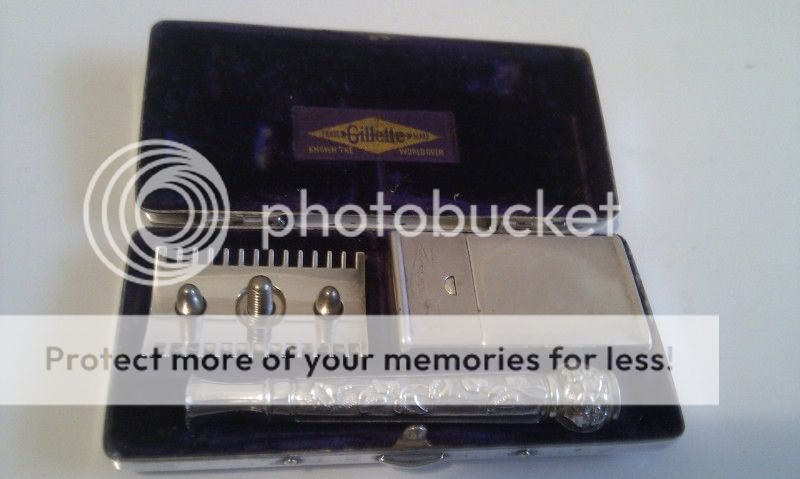Gillette pocket edition
- Thread starter nightguard
- Start date
It should be 1918, but I don't think I've seen one with a serial number placed on that side of the plate before. Can you take a picture of just the plate with the numbers?
It is not a Gillette pocket edition, its a Basket weave ABC Pocket edition. Date codes: 1918-E449208-J7344
Last edited:
They seem to have had different handles from Shell, Ball End to Plain
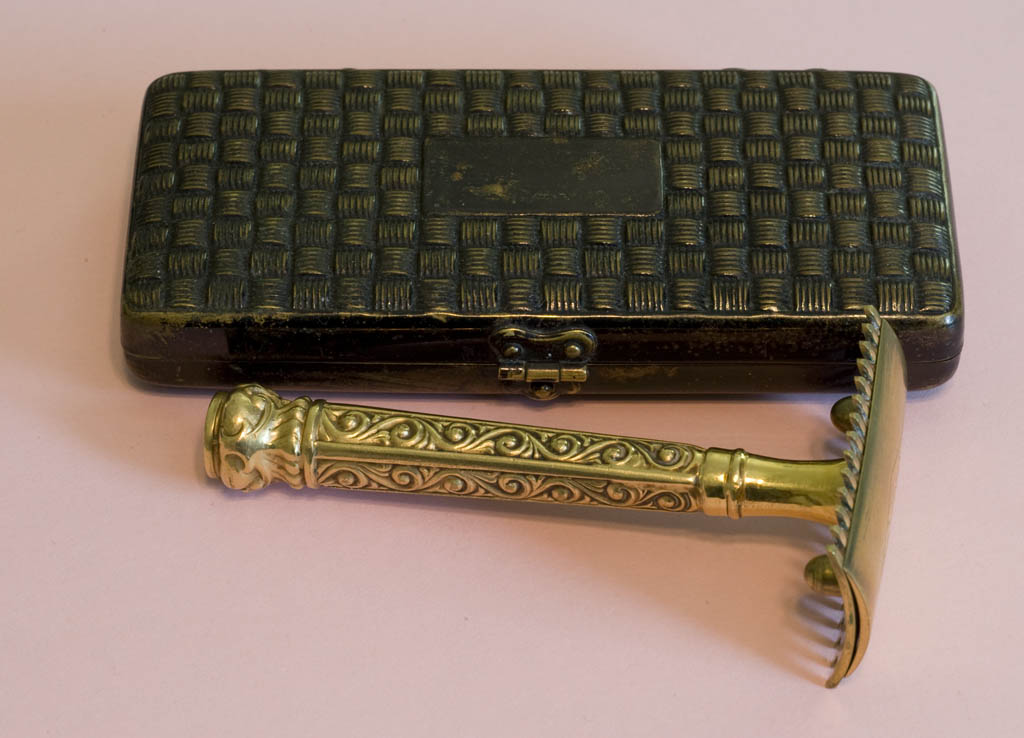

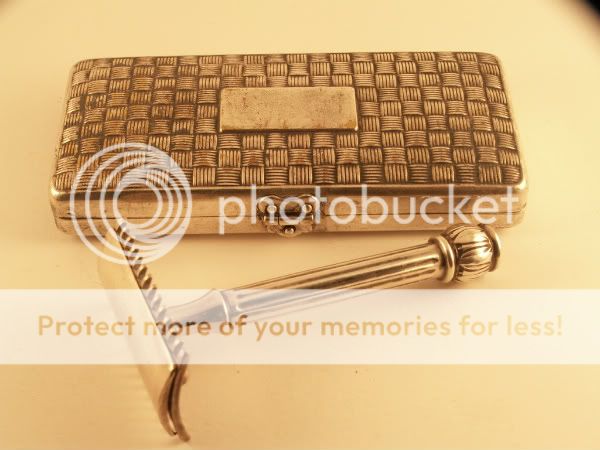

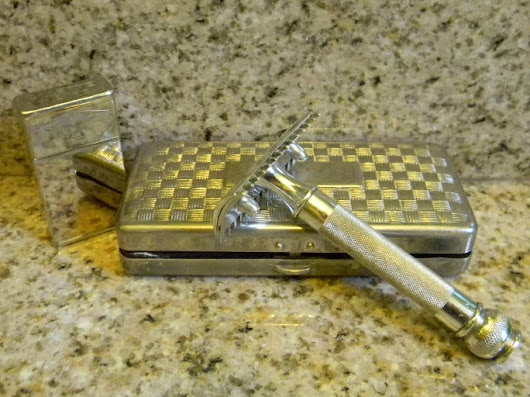
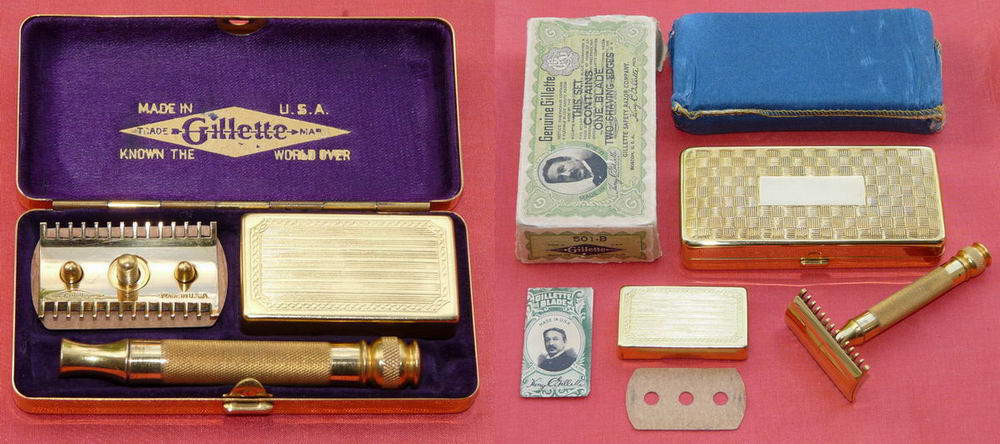





Huh, I have one just like that. Neat. Mine's from 1913 I believe. I'd have to check what the exact serial number is on it. One of the ways you can tell an ABC Empire Pocket Edition from a Gillette Pocket Edition is that the Gillette logo on the inside of the case on the ABC Empire Pocket Edition is a little different from the Gillette Pocket Editions..... even though they both say Gillette.
Ben
Ben
Huh, I have one just like that. Neat. Mine's from 1913 I believe. I'd have to check what the exact serial number is on it. One of the ways you can tell an ABC Empire Pocket Edition from a Gillette Pocket Edition is that the Gillette logo on the inside of the case on the ABC Empire Pocket Edition is a little different from the Gillette Pocket Editions..... even though they both say Gillette.
Ben
A print of patent dates on the bottom of the case. Cases made by Gillette do not have this imprint, but American Button Company/ABC cases do.

......American Button Company/ABC cases have a patch with the Gillette trademark diamond logo, and it the Made in USA stitching. Cases with a patch that have the Made in USA stitching are made by Gillette.



Last edited:
I know that's what the serial number would suggest, but 1918 would be strangely late for an ABC set. They don't appear in any of the catalogs I've seen after 1914, and they disappear from the advertising record right around that same time, too. The same 1915 Christmas ads that show the full expanded lineup with the new Bulldog, Aristocrat, and Milady Décolletée also show the standard ball-end Old Type in the Pocket Edition rather than the ABC handle. I'd be slightly more inclined to believe that this is another "out of series" oddity that we don't fully understand.
Achim's got one of these same sets with the serial number on the bottom of the guard plate up in his collection (below). I wonder if his case also has the amended British stamping like yours does. I've generally only seen that on sets that came from European sellers, as though it was added later perhaps in response to a change in British law requiring the patent number to be listed, and not just the date. It does appear that later ABC cases appear to have changed the inscription to list the patent numbers for most of the countries. If that's correct, then this set would seem like it ought to be earlier than that change, making the serial number definitely not line up with the standard series.
It's also strange that your set seems to have "1913" scratched into the bottom at least a couple of times there, nightguard, not that that necessarily means anything reliable.

Achim's got one of these same sets with the serial number on the bottom of the guard plate up in his collection (below). I wonder if his case also has the amended British stamping like yours does. I've generally only seen that on sets that came from European sellers, as though it was added later perhaps in response to a change in British law requiring the patent number to be listed, and not just the date. It does appear that later ABC cases appear to have changed the inscription to list the patent numbers for most of the countries. If that's correct, then this set would seem like it ought to be earlier than that change, making the serial number definitely not line up with the standard series.
It's also strange that your set seems to have "1913" scratched into the bottom at least a couple of times there, nightguard, not that that necessarily means anything reliable.

I was wondering about that mystery too, but I was letting you chime in on the oddity. You may have more insight than me since you do have many of these and i dont. ( I dont collect as you do)......I know that's what the serial number would suggest, but 1918 would be strangely late for an ABC set. They don't appear in any of the catalogs I've seen after 1914, and they disappear from the advertising record right around that same time, too. The same 1915 Christmas ads that show the full expanded lineup with the new Bulldog, Aristocrat, and Milady Décolletée also show the standard ball-end Old Type in the Pocket Edition rather than the ABC handle. I'd be slightly more inclined to believe that this is another "out of series" oddity that we don't fully understand.
Achim's got one of these same sets with the serial number on the bottom of the guard plate up in his collection (below). I wonder if his case also has the amended British stamping like yours does. I've generally only seen that on sets that came from European sellers, as though it was added later perhaps in response to a change in British law requiring the patent number to be listed, and not just the date. It does appear that later ABC cases appear to have changed the inscription to list the patent numbers for most of the countries. If that's correct, then this set would seem like it ought to be earlier than that change, making the serial number definitely not line up with the standard series.
It's also strange that your set seems to have "1913" scratched into the bottom at least a couple of times there, nightguard, not that that necessarily means anything reliable.

So when was the law requiring the change/ Patent number listing? After 1915/16 or before? If it is on 1915 then that can explain some of these late sets.
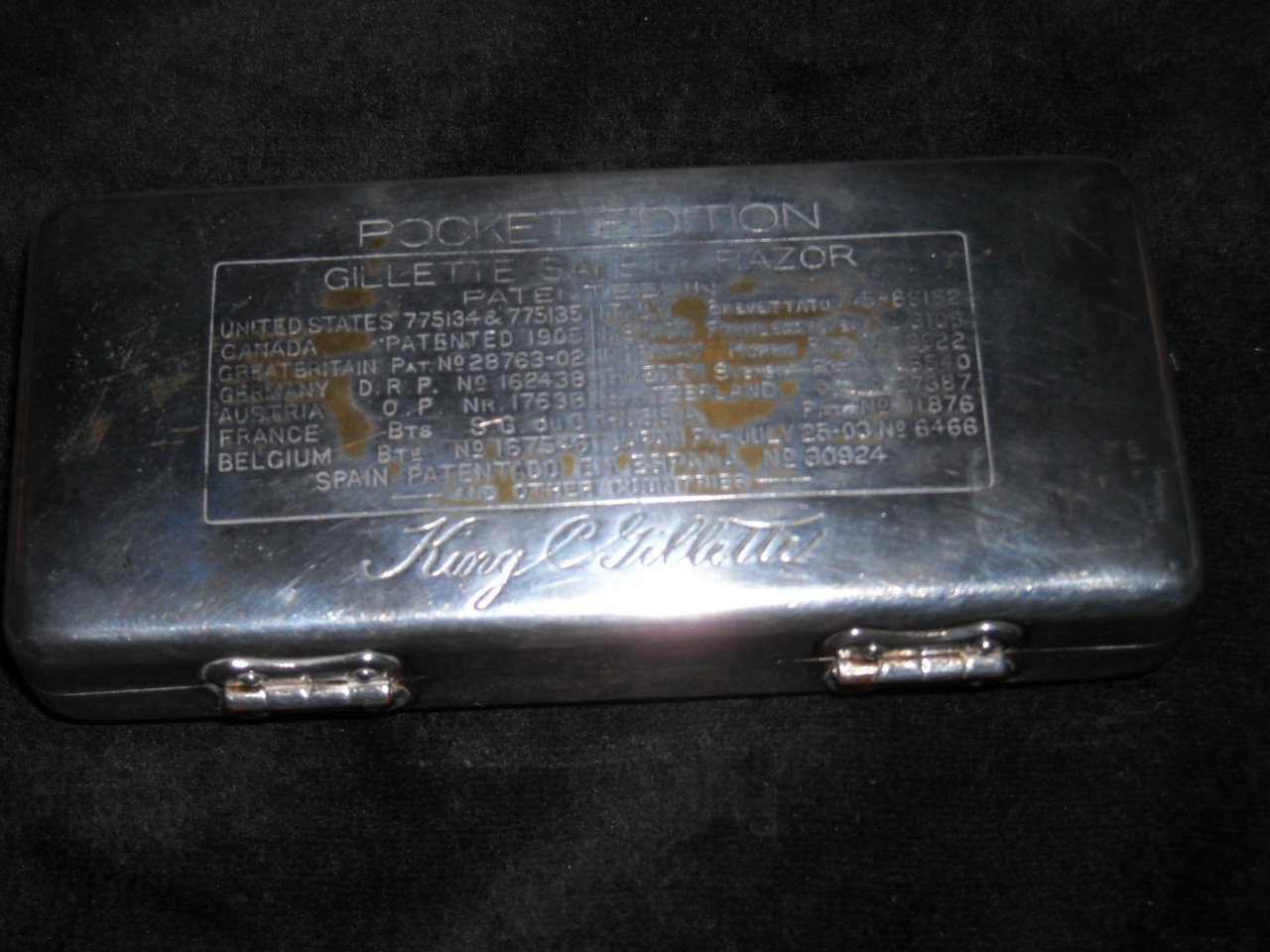
Last edited:
- Thread starter
- #10
- Thread starter
- #11
Definitely cool. Porter I believe has a single ring that has marking similar to yours as well. His is a British set as yours appears to be as well. He'll be around shortly...
Definitely cool. Porter I believe has a single ring that has marking similar to yours as well. His is a British set as yours appears to be as well. He'll be around shortly...
dont tell him what to do lol
Definitely cool. Porter I believe has a single ring that has marking similar to yours as well. His is a British set as yours appears to be as well. He'll be around shortly...
dont tell him what to do lol
Yeah! Don't tell me what to -- Oh well, since I'm already here...
So when was the law requiring the change/ Patent number listing? After 1915/16 or before? If it is on 1915 then that can explain some of these late sets.
I wasn't saying that there definitely was a change. I was just giving an example of a reason why they might have changed the inscription, which would otherwise seem like a strange thing to do.
What would the significance of 1915 be one way or the other? From the other thread it looks like the patent numbered cases start around 1914, and I really wouldn't expect to see an ABC set past 1915 give or take, though that end point is really still rather unclear.
View attachment 338388 View attachment 338391Thanks to every one for the replies, after a bit of further cleaning I can now read the inscriptions on the back, J. Bottrill at one end, I assume the original owner and at the other end 23/11/1913.
That's very interesting. It's also interesting that the head is stamped in the same fashion as some of those Single Rings that we see coming out of England, like elmerwood mentioned. I wonder if it was supplied unstamped to the Gillette plant that was operating in Leicester prior to WWI and the stamping was applied there. There's another aspect of the serial number that would suggest that it didn't come out of the Boston plant stamped that way, and that's the fact that they used a leading zero on the number: G051727. The way the Boston plant did it was to just leave a blank, so if it were stamped there I'd expect it to be "G 51727" instead. But the Canadian and British plants did seem to use leading zeroes.
If I were going to enter into the realm of totally wild conjecture, I might hypothesize that, as the likely main entry point into into the European market, perhaps the British plant used different letter prefixes to designate the destination country for the razor sets during these early years -- "E" for razors sold directly in the English market, "F" for France, "G" for Germany, etc. That's mostly just me talking out of my backside at this point, though.
That aside, the 1913 date that's scratched on the back is certainly possible. It's earlier than the 1914 date where we have seen the case inscription change to the patent numbers, and it's also before the start of the war when the Leicester plant would have definitely still been operating.
Last edited:
- Thread starter
- #16
Thanks for all the info, nice to know a bit of history behind what is, one of the best looking razors in little collection, hopefully it will shave as good as it looks.
That's very interesting. It's also interesting that the head is stamped in the same fashion as some of those Single Rings that we see coming out of England, like elmerwood mentioned. I wonder if it was supplied unstamped to the Gillette plant that was operating in Leicester prior to WWI and the stamping was applied there. There's another aspect of the serial number that would suggest that it didn't come out of the Boston plant stamped that way, and that's the fact that they used a leading zero on the number: G051727. The way the Boston plant did it was to just leave a blank, so if it were stamped there I'd expect it to be "G 51727" instead. But the Canadian and British plants did seem to use leading zeroes.
If I were going to enter into the realm of totally wild conjecture, I might hypothesize that, as the likely main entry point into into the European market, perhaps the British plant used different letter prefixes to designate the destination country for the razor sets during these early years -- "E" for razors sold directly in the English market, "F" for France, "G" for Germany, etc. That's mostly just me talking out of my backside at this point, though.
That aside, the 1913 date that's scratched on the back is certainly possible. It's earlier than the 1914 date where we have seen the case inscription change to the patent numbers, and it's also before the start of the war when the Leicester plant would have definitely still been operating.
Porter, do you have any information on when the Leicester plant ceased operations? It may not make much difference for this particular piece, but I have not been able to establish a clear date. We have a note in the Gillette_Timeline under 1912: "Leicester plant closed" - but I am not so sure it is accurate.
The source for the 1912 date is Chemist & Druggist, vol. 128, p342 from 1938. This is in snippet view in google books. The text preview reads "A factory for both razors and blades was opened at Leicester, but in 1912 this was closed and the British market was supplied from the United States until 1920, when it was decided to establish a factory at Slough...." That source may not be authoritative, though. There is a conflicting mention of January 1916 in Magistrates Cases, vol. 89, p1196 from 1920 - more snippet view, but it reads "The appellant company moved out of the Leicester factory in January, 1916, upon which it was disposed of by the U.S.A. company." Poor's Manual of Industrials for 1917 still mentions Leicester. The 1918 Gillette Blade is silent on the subject.
Lacking other evidence I suppose we should believe the earlier 1920 source over the 1938 source: less time for misinformation. In that case January 1916 is more likely to be correct. What do you think?
Advertising may help too. So far the last mention of Leicester in a Gillette ad seems to be the second half of 1914 in Windsor Magazine. That tends to support 1916.
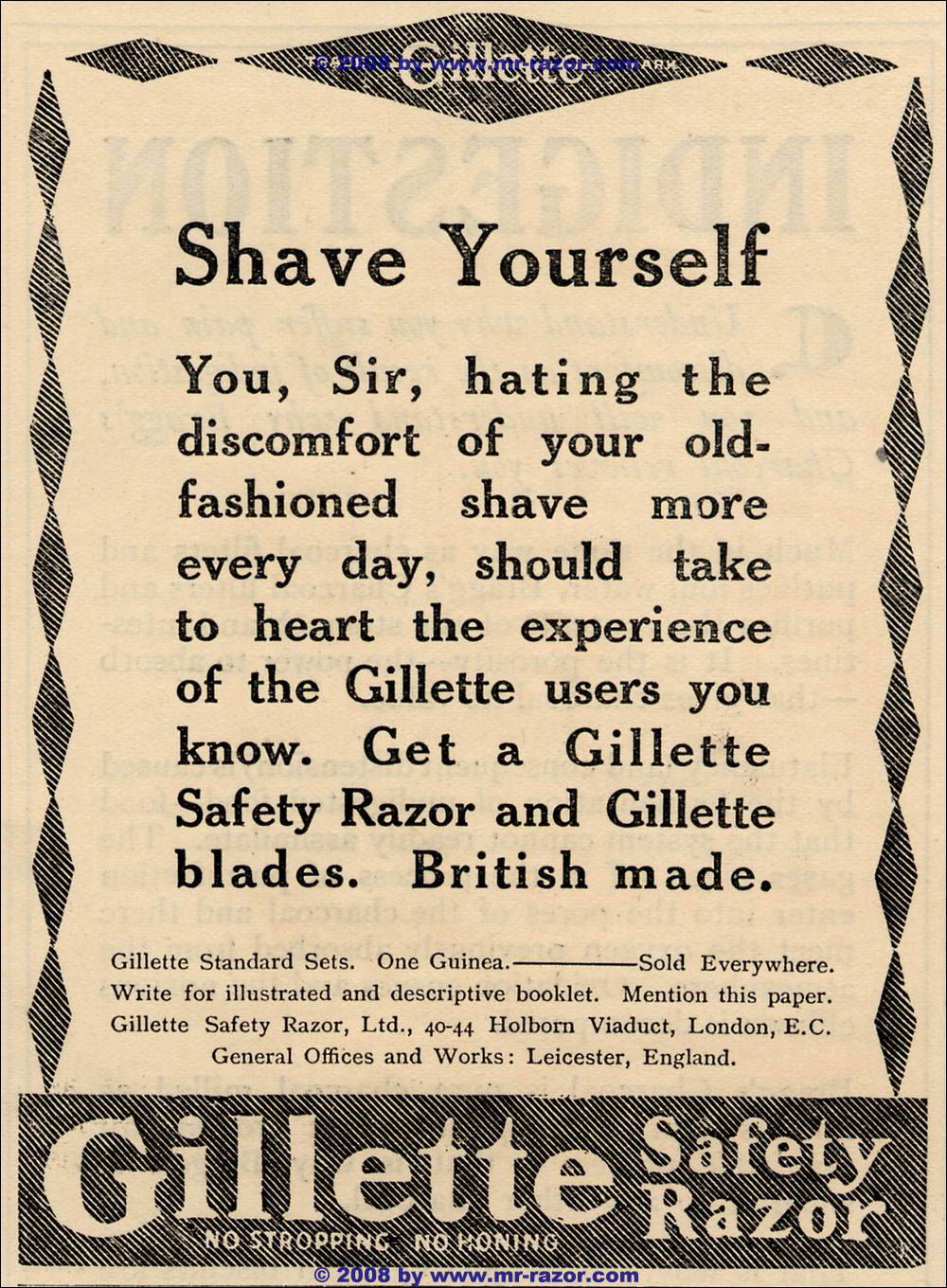
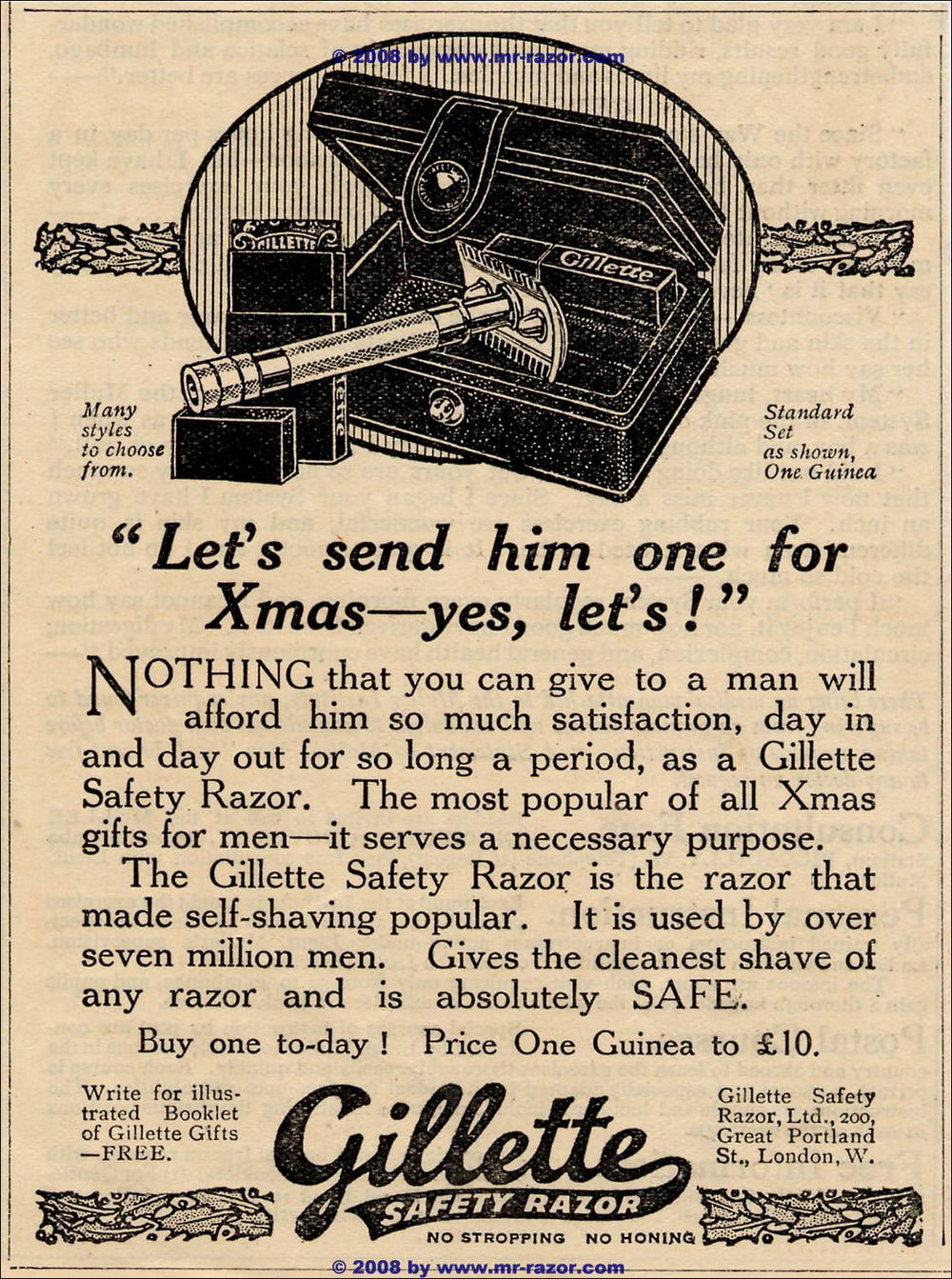
Last edited:
Porter, do you have any information on when the Leicester plant ceased operations? It may not make much difference for this particular piece, but I have not been able to establish a clear date. We have a note in the Gillette_Timeline under 1912: "Leicester plant closed" - but I am not so sure it is accurate.
The source for the 1912 date is Chemist & Druggist, vol. 128, p342 from 1938. This is in snippet view in google books. The text preview reads "A factory for both razors and blades was opened at Leicester, but in 1912 this was closed and the British market was supplied from the United States until 1920, when it was decided to establish a factory at Slough...." That source may not be authoritative, though. There is a conflicting mention of January 1916 in Magistrates Cases, vol. 89, p1196 from 1920 - more snippet view, but it reads "The appellant company moved out of the Leicester factory in January, 1916, upon which it was disposed of by the U.S.A. company." Poor's Manual of Industrials for 1917 still mentions Leicester. The 1918 Gillette Blade is silent on the subject.
Lacking other evidence I suppose we should believe the earlier 1920 source over the 1938 source: less time for misinformation. In that case January 1916 is more likely to be correct. What do you think?
The only other resources I have appear to be alternate publishings of the same material that is in that Magistrates Cases piece, such as these from Law Reports: King's Bench Division and Law Reports: Queen's Bench Division. I'm also a bit more inclined to trust the information there than I am the Chemist & Druggist piece. The 1912 date wouldn't really make a lot of sense... It's always seemed more like it was WWI that disrupted their manufacturing there than a business decision to close the factory, and I can certainly see them trying to hold on through the early years of the war which is more what the information in the court documents seems to suggest.
I would love to get my hands on a copy of the full text, as I've only ever walked through about a page or so of the Snippet View contents. But I suppose I can do a bit more digging that way and see what I can assemble. Thankfully the snippets between the various sources don't all exactly line up so you can use the last lines from one to get the first lines from another.

...
Achim's got one of these same sets with the serial number on the bottom of the guard plate up in his collection (below). I wonder if his case also has the amended British stamping like yours does. ...
I´ve make some new pictures and have delete the old picture with the wrong date on my site. The scratched "1913" on @nightguard´s set was a big help to date this set:
I´ve make some new pictures and have delete the old picture with the wrong date on my site. The scratched "1913" on @nightguard´s set was a big help to date this set:
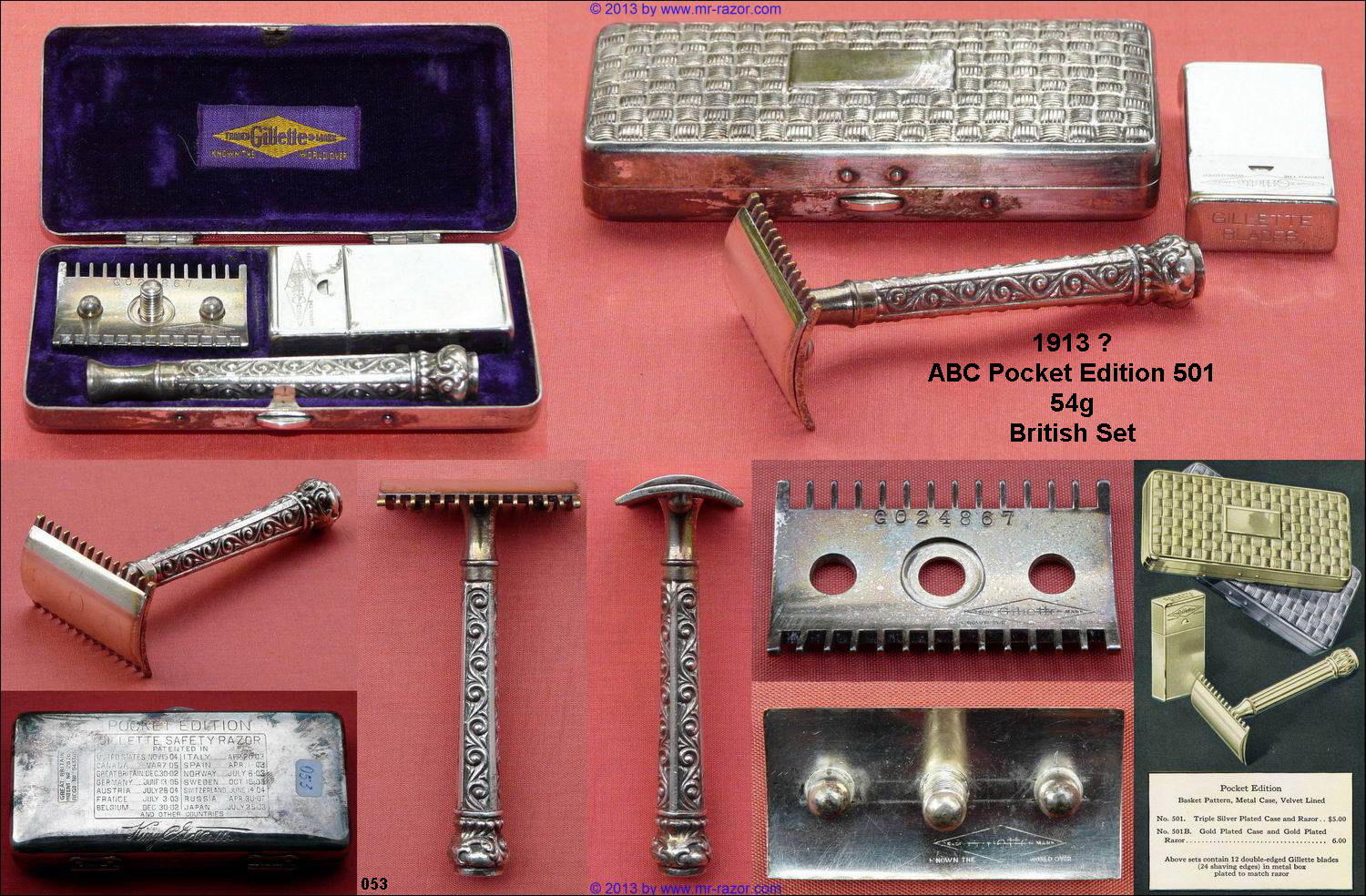
Does anyone notice the razor in the picture in the bottom left of Achim's post is not the "Scroll" but the exact razor the Op has.....
The Op has a perfectly complete set in my eyes.
Similar threads
- Replies
- 6
- Views
- 937
- Replies
- 10
- Views
- 2K
- Locked
- Article
- Replies
- 7
- Views
- 936








